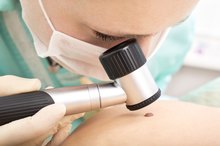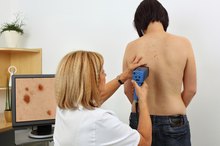Melanoma Vs. Age Spots
Both melanoma and age spots can cause brown lesions on the skin. It is very important to differentiate these two skin conditions. While age spots can be a cosmetic nuisance, they are harmless. Melanoma, however, can be deadly.
In fact, melanoma is the most dangerous form of skin cancer. Although melanoma and age spots share some common features, there are some distinguishing characteristics.
Melanoma
A 2016 report from the American Cancer Society reports that melanoma accounts for only 1 percent of all skin cancers in the U.S. but is responsible for the overwhelming majority of skin cancer deaths 1. Melanoma occurs when the pigment cells, or melanocytes, in the skin become cancerous.
Skin lesions due to melanoma may be raised or flat and are often dark brown or black.
However, color variation within the lesion is very common with melanoma. This can include variable shades of brown, black, red, blue and even white. Other common characteristics of melanoma include: -- asymmetry, meaning one half doesn't mirror the other half -- irregular or poorly defined borders -- size larger than 6 mm, or about the size of a pencil eraser -- change in shape, color and/or size over time
Melanoma can develop at any age in adults, although the risk increases with advancing age. It occurs rarely in young children, but can develop in adolescents.
Melanomas may arise in a preexisting mole or develop anew. Unlike age spots, melanomas often itch, bleed easily or are tender.
- A 2016 report from the American Cancer Society reports that melanoma accounts for only 1 percent of all skin cancers in the U.S. but is responsible for the overwhelming majority of skin cancer deaths 1.
- Other common characteristics of melanoma include: -- asymmetry, meaning one half doesn't mirror the other half -- irregular or poorly defined borders -- size larger than 6 mm, or about the size of a pencil eraser -- change in shape, color and/or size over time Melanoma can develop at any age in adults, although the risk increases with advancing age.
Age Spots
Differences between Malignant Melanoma and a Normal Mole
Learn More
Age spots -- also known as liver spots or solar lentigines -- are linked to aging and exposure to ultraviolet (UV) radiation from the sun or tanning bed use.
Age spots develop when skin damage caused by UV radiation caused increased proliferation of melanocytes and other cells in the superficial layer of the skin.
A brownish pigment called melanin produced by the melanocytes accumulates in the upper layer of the skin leading to age spots. Age spots typically make their initial appearance in middle-aged adults, and tend to gradually increase in size and number over the years as a person ages.
Like freckles, solar lentigines are characteristically flat and multiple spots tend to occur together in an affected area. Unlike freckles, however, age spots do not fade. **They are most commonly light brown, but can be dark brown or black.
In contrast to melanoma skin lesions, age spots are characteristically uniform in color. They can be round, oval or irregular in shape. However, they have distinct borders and remain relatively stable in appearance over time, though they may enlarge very slowly over a period of years. Unlike melanoma skin lesions, age spots do not cause any symptoms. **
- Age spots -- also known as liver spots or solar lentigines -- are linked to aging and exposure to ultraviolet (UV) radiation from the sun or tanning bed use.
- Like freckles, solar lentigines are characteristically flat and multiple spots tend to occur together in an affected area.
Prevention
People with fair skin and those who have a history of heavy sun exposure are at increased risk for age spots, melanoma and other forms of skin cancer. To prevent sun-related skin damage, the American Academy of Dermatology advises daily use of sunscreen with an SPF of 30 or higher, even on cloudy days.
Be sure to choose a sunscreen that provides specific protection for both UVA and UVB, two types of damaging ultraviolet radiation from the sun. Wearing protective clothing and minimizing time outside when the sun is most powerful -- between 10 a.m. and 2 p.m., is recommended as well.
- People with fair skin and those who have a history of heavy sun exposure are at increased risk for age spots, melanoma and other forms of skin cancer.
- To prevent sun-related skin damage, the American Academy of Dermatology advises daily use of sunscreen with an SPF of 30 or higher, even on cloudy days.
Treatment
Facts About Red Moles
Learn More
Age spots do not require treatment, although it's possible to treat them cosmetically with fading creams or laser treatments. If melanoma is diagnosed before it has spread to other organs, it is highly curable. Melanoma must be surgically removed. Depending on the size of the lesion, melanoma can sometimes be removed in a dermatologist's office. If melanoma has invaded deep into the skin or spread to other organs, chemotherapy or radiation therapy may be necessary.
- Age spots do not require treatment, although it's possible to treat them cosmetically with fading creams or laser treatments.
- Depending on the size of the lesion, melanoma can sometimes be removed in a dermatologist's office.
Warnings and Precautions
Age spots are not cancerous, but they do indicate UV skin damage, a major risk factor for skin cancer.
**As such, people with age spots should keep an eye out for other potentially cancerous skin growths.
** If you have multiple moles or age spots, it's a good idea to have an annual skin exam.
If you notice a mole or spot on your skin that looks unusual or has changed in appearance, see your doctor as soon as possible. Early diagnosis and treatment can be life-saving.
Reviewed by: Tina M. St. John, M.D.
- Age spots are not cancerous, but they do indicate UV skin damage, a major risk factor for skin cancer.
- As such, people with age spots should keep an eye out for other potentially cancerous skin growths.
Related Articles
References
- American Cancer Society: Cancer Facts and Figures 2016
- Dermatology Times: Solar Lentigines, While Common in Older Adults, Can Indicate Malignancy
- Pediatrics: Incidence of Childhood and Adolescent Melanoma in the United States: 1973-2009
- National Cancer Institute: Melanoma Treatment (PDQ) -- Health Professional Version
- PDQ Adult Treatment Editorial Board. Melanoma Treatment (PDQ®): Patient Version. 2019 Nov 8. In: PDQ Cancer Information Summaries [Internet]. Bethesda (MD): National Cancer Institute (US); 2002-.
- InformedHealth.org [Internet]. Cologne, Germany: Institute for Quality and Efficiency in Health Care (IQWiG); 2006-. Detecting melanoma. 2015 Sep 10 [Updated 2018 Nov 29].
- D'Orazio J, Jarrett S, Amaro-Ortiz A, Scott T. UV radiation and the skin. Int J Mol Sci. 2013;14(6):12222–12248. Published 2013 Jun 7. doi:10.3390/ijms140612222
- Riker AI, Zea N, Trinh T. The epidemiology, prevention, and detection of melanoma. Ochsner J. 2010;10(2):56–65. PMID: 21603359
- Bastian BC. The molecular pathology of melanoma: an integrated taxonomy of melanocytic neoplasia. Annu Rev Pathol. 2014;9:239–271. doi:10.1146/annurev-pathol-012513-104658
- McCourt C, Dolan O, Gormley G. Malignant melanoma: a pictorial review. Ulster Med J. 2014;83(2):103–110. PMID: 25075139
- Goodson AG, Grossman D. Strategies for early melanoma detection: Approaches to the patient with nevi. J Am Acad Dermatol. 2009;60(5):719–738. doi:10.1016/j.jaad.2008.10.065
- Ward WH. Clinical Presentation and Staging of Melanoma. Cutaneous Melanoma: Etiology and Therapy [Internet]. Published December 21, 2017.
- Liu Y, Sheikh MS. Melanoma: Molecular Pathogenesis and Therapeutic Management. Mol Cell Pharmacol. 2014;6(3):228. PMID: 25745537
- Corneli P, Zalaudek I, Magaton rizzi G, Di meo N. Improving the early diagnosis of early nodular melanoma: can we do better?. Expert Rev Anticancer Ther. 2018;18(10):1007-1012. doi:10.1080/14737140.2018.1507822
- Cohen LM. Lentigo maligna and lentigo maligna melanoma. J Am Acad Dermatol. 1995;33(6):923-36. doi:10.1016/0190-9622(95)90282-1
- Criscito MC, Stein JA. Improving the diagnosis and treatment of acral melanocytic lesions. Melanoma Manag. 2017;4(2):113–123. doi:10.2217/mmt-2016-0017
- Du F, Yang M, Fang J, Jing C. Primary hepatic malignant melanoma: a case report. Int J Clin Exp Pathol. 2015;8(2):2199–2201. Published 2015 Feb 1. PMID: 25973128
- Brahmer JR, Lacchetti C, Schneider BJ, et al. Management of Immune-Related Adverse Events in Patients Treated With Immune Checkpoint Inhibitor Therapy: American Society of Clinical Oncology Clinical Practice Guideline. J Clin Oncol. 2018;36(17):1714–1768. doi:10.1200/JCO.2017.77.6385
- Bertolotto C. Melanoma: from melanocyte to genetic alterations and clinical options. Scientifica (Cairo). 2013;2013:635203. doi:10.1155/2013/635203
- Institute for Quality and Efficiency in Health Care (IQWiG). What increases your risk of melanoma? InformedHealth.org [Internet]. Published November 29, 2018.
- Rangwala S, Tsai KY. Roles of the immune system in skin cancer. Br J Dermatol. 2011;165(5):953–965. doi:10.1111/j.1365-2133.2011.10507.x
- Gupta AK, Bharadwaj M, Mehrotra R. Skin Cancer Concerns in People of Color: Risk Factors and Prevention. Asian Pac J Cancer Prev. 2016;17(12):5257–5264. Published 2016 Dec 1. doi:10.22034/APJCP.2016.17.12.5257
- Wu S, Cho E, Li WQ, Weinstock MA, Han J, Qureshi AA. History of Severe Sunburn and Risk of Skin Cancer Among Women and Men in 2 Prospective Cohort Studies. Am J Epidemiol. 2016;183(9):824–833. doi:10.1093/aje/kwv282
- Kaliyadan F. The scope of the dermoscope. Indian Dermatol Online J. 2016;7(5):359–363. doi:10.4103/2229-5178.190496
- Abbasi NR, Shaw HM, Rigel DS, et al. Early diagnosis of cutaneous melanoma: revisiting the ABCD criteria. JAMA. 2004;292(22):2771-6. doi:10.1001/jama.292.22.2771
- Shenenberger DW. Cutaneous malignant melanoma: a primary care perspective. Am Fam Physician. 2012;85(2):161-8. PMID: 22335216
- Bennett JP, Hall P. Moles and melanoma: a history. Ann R Coll Surg Engl. 1994;76(6):373–380. PMID: 7702317
- Gaudy-marqueste C, Wazaefi Y, Bruneu Y, et al. Ugly Duckling Sign as a Major Factor of Efficiency in Melanoma Detection. JAMA Dermatol. 2017;153(4):279-284. doi:10.1001/jamadermatol.2016.5500
- Mohr P, Eggermont AM, Hauschild A, Buzaid A. Staging of cutaneous melanoma. Ann Oncol. 2009;20 Suppl 6(Suppl 6):vi14–vi21. doi:10.1093/annonc/mdp256
- PDQ Adult Treatment Editorial Board. Melanoma Treatment (PDQ®): Patient Version. 2019 Nov 8. In: PDQ Cancer Information Summaries [Internet]. Bethesda (MD): National Cancer Institute (US); 2002-.
- Erdei E, Torres SM. A new understanding in the epidemiology of melanoma. Expert Rev Anticancer Ther. 2010;10(11):1811–1823. doi:10.1586/era.10.170
- Wernick BD, Goel N, Zih FS, Farma JM. A surgical perspective report on melanoma management. Melanoma Manag. 2017;4(2):105–112. doi:10.2217/mmt-2016-0031
- Bagaria SP, Faries MB, Morton DL. Sentinel node biopsy in melanoma: technical considerations of the procedure as performed at the John Wayne Cancer Institute. J Surg Oncol. 2010;101(8):669–676. doi:10.1002/jso.21581
- Sadozai H, Gruber T, Hunger RE, Schenk M. Recent Successes and Future Directions in Immunotherapy of Cutaneous Melanoma. Front Immunol. 2017;8:1617. Published 2017 Dec 8. doi:10.3389/fimmu.2017.01617
- Mattia G, Puglisi R, Ascione B, Malorni W, Carè A, Matarrese P. Cell death-based treatments of melanoma:conventional treatments and new therapeutic strategies. Cell Death Dis. 2018;9(2):112. Published 2018 Jan 25. doi:10.1038/s41419-017-0059-7
- Testori A, Rutkowski P, Marsden J, et al. Surgery and radiotherapy in the treatment of cutaneous melanoma. Ann Oncol. 2009;20 Suppl 6(Suppl 6):vi22–vi29. doi:10.1093/annonc/mdp257
- Glanz K, Buller DB, Saraiya M. Reducing ultraviolet radiation exposure among outdoor workers: state of the evidence and recommendations. Environ Health. 2007;6:22. Published 2007 Aug 8. doi:10.1186/1476-069X-6-22
- Autier P. Do high factor sunscreens offer protection from melanoma?. West J Med. 2000;173(1):58. doi:10.1136/ewjm.173.1.58
- Le Clair MZ, Cockburn MG. Tanning bed use and melanoma: Establishing risk and improving prevention interventions. Prev Med Rep. 2016;3:139–144. Published 2016 Jan 14. doi:10.1016/j.pmedr.2015.11.016
- Weinstock MA, Risica PM, Martin RA, et al. Melanoma early detection with thorough skin self-examination: the "Check It Out" randomized trial. Am J Prev Med. 2007;32(6):517–524. doi:10.1016/j.amepre.2007.02.024
- InformedHealth.org [Internet]. Cologne, Germany: Institute for Quality and Efficiency in Health Care (IQWiG); 2006-. Detecting melanoma. 2015 Sep 10 [Updated 2018 Nov 29].
- Walter FM, Humphrys E, Tso S, Johnson M, Cohn S. Patient understanding of moles and skin cancer, and factors influencing presentation in primary care: a qualitative study. BMC Fam Pract. 2010;11:62. Published 2010 Aug 31. doi:10.1186/1471-2296-11-62
- Bode AM, Dong Z. Cancer prevention research - then and now. Nat Rev Cancer. 2009;9(7):508–516. doi:10.1038/nrc2646
- How to Do a Skin Self-Exam. American Cancer Society. Published July 23, 2019.
Writer Bio
Niya Jones is a physician and medical writer. She is board-certified in internal medicine and has a special interest in cardiology, particularly as it relates to health care disparities and women's health. She received her medical degree and Masters of public health from Yale University.









